
Shunt reactor technology: Three world records in three years
Abstract Variable shunt reactors (VSR) with on-line tap changers are a cost-effective solution for compensation of reactive power and maintaining voltage stability, especially with the...
bySaskia BAUMANN

Abstract
Variable shunt reactors (VSR) with on-line tap changers are a cost-effective solution for compensation of reactive power and maintaining voltage stability, especially with the growing use of renewable power sources characterized by volatile demand of reactive power. Shunt reactor is based on an iron core design with air gaps which must be created to ensure mechanical stability with low vibration and noise. The wide regulation range of a VSR provides the correct amount of reactive power in small enough steps to avoid its switching on and off, thus preventing big switching impulses in the grid. For off-shore wind parks, the ester-filled shunt reactor is a promising solution which increases environmental safety.
Keywords: variable shunt reactor, core with air gap, reactive power, renewable sources
1. Introduction
With the increasing infeed of renewable powers, which are fluctuating by nature, a reliable and secure power supply is becoming increasingly challenging. Reactors are a crucial component in meeting current and upcoming challenges. This led to three world records in the last three years.
Shunt reactors are either series reactors or compensating reactors which are used as an inductive load to control the voltage and provide reactive power compensation. These reactors are connected between transmission voltage and earth. The target is to have a high inductive power but with small dimensions. Windings, insulation, tank, monitoring equipment and tap-changers are known components of transformer technology. The technological heart and the main difference to a transformer is the core of a reactor. The best and most renowned technology is an iron core design with air gaps, in which only few suppliers have a lot of experience and expertise. This iron core design with air gaps leads to a compact design, with low noise, vibration and losses. Another benefit of the iron core with air gaps is the dampening effect (knee point voltage) that limits voltage under extreme overcurrent conditions. The core is made from radially laminated iron packages, while ceramic spacers ensure precise compliance with the specific air gap requirements. The core is clamped together by tie rods made of steel and/or wooden limbs, and held in place with the iron yoke and return circuit in a clamping frame. High-quality suppliers can offer, design and build two different types of core concepts. The first is inner clamping, where the tie rods are inserted through holes in the core. This results in a compact design at high voltages in particular and, thanks to the optimized force transmission, with a minimum amount of noise. The second is outer clamping concept, where the tie rods are located outside the core and winding which, at low voltages or in single phase reactors, reduces the unit weight (core and winding). In addition, the spring technology between the tie rod and crossbeam ensures constant core pressing. This results in a constant low vibration and noise level over the entire life of high-quality reactors.
The iron core keeps and concentrates the magnetic flux generated by the windings, which needs to overcome the air gaps. Thanks to the big differences in the permeability of electrical steel and oil, or rather air, it is sufficient to set the magnetic resistance of the air gaps for the series connection of iron and air gaps. Air gaps reduce the inductivity and increase the power of this arrangement.







